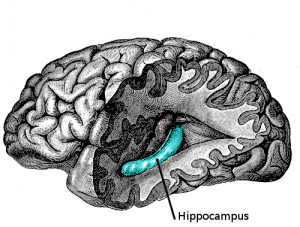Link Between Hippocampus and Memory
The ability of the brain to store and later retrieve information is remarkable. Detailed, complex memories can be formed after as little as one exposure, and those memories can be retained for decades. This ability is compromised following damage to structures located in the medial temporal lobe, including the hippocampus and the adjacent entorhinal cortex. The link between the hippocampus and memory has been appreciated since the report of the famous case of patient H.M., who suffered a dense amnesia following removal of the hippocampus and adjacent cortex in order to relieve otherwise intractable epilepsy. Subsequent studies in rats, nonhuman primates, and human patients have demonstrated that the integrity of medial temporal lobe structures is critical for normal memory ability.
Place Cells
 While it has long been recognized that these structures are important for memory, a largely parallel line of research in rodents has highlighted the contribution of these same structures to our sense of space. This line of research began in the 1970’s with the discovery of hippocampal “place cells” – neurons that are selectively active when an animal moves through specific locations in an environment, with each neuron active in a distinct location. Recordings from many of these neurons simultaneously provide an exquisite map of the animal’s environment. Accordingly, these neurons are thought to aid in spatial navigation and constitute an internal or cognitive map.
While it has long been recognized that these structures are important for memory, a largely parallel line of research in rodents has highlighted the contribution of these same structures to our sense of space. This line of research began in the 1970’s with the discovery of hippocampal “place cells” – neurons that are selectively active when an animal moves through specific locations in an environment, with each neuron active in a distinct location. Recordings from many of these neurons simultaneously provide an exquisite map of the animal’s environment. Accordingly, these neurons are thought to aid in spatial navigation and constitute an internal or cognitive map.
What is currently unclear, however, is how this cognitive map contributes to memory formation, which is considered the primary function of these brain structures. While spatial information is a critical component of episodic memory, or memory for past events in one’s life, the details of how memories are formed and the relationship between spatial and mnemonic representations are not well understood, particularly in the primate brain.
Consensus between the memory and spatial views has been difficult because of differences in the species and approaches used – most experiments on memory involve human subjects, whereas most experiments on spatial cognition involve maze behavior in rodents. Research in nonhuman primates presents an opportunity to bridge the gap between the more invasive research of cells and circuits that have been investigated in rodents and complex behaviors that can be measured in humans. A recent focus of research in the Buffalo lab is to take advantage of the complex memory abilities that can be demonstrated by nonhuman primates, along with recordings from single neurons and neuronal ensembles, in order to try to bridge the gap between the spatial and mnemonic views of hippocampal function.
Using Virtual Reality to Examine Brain Activity
One exciting new way that we are addressing these issues involves the development of behavioral tasks for the monkey using virtual reality coupled with neurophysiological recordings. This technique allows us to examine hippocampal activity during environmental navigation and to investigate neural activity in the medial temporal lobe that may underlie complex behaviors.
We have successfully implemented techniques in our laboratory for assessing neuronal activity along with eye movements as monkeys are engaged in virtual 3D navigation. In addition, we have successfully trained monkeys to use a joystick to navigate through the environment, obtaining reward for navigating to specific targets. One exciting preliminary result from our recordings in the hippocampus is the identification of a prominent theta rhythm (3-8 Hz) during virtual movement, the peak frequency of which is strongly correlated to the frequency of eye movements. We are also examining hippocampal activity as the monkeys perform spatial memory tasks in which they are rewarded for remembering the location of hidden targets in the virtual environment. We have identified patterns of neural activity, in the form of enhanced gamma-band (30-90 Hz) correlated activity that is predictive of successful memory performance.
Goal: Restore Memory
One goal of this work is to find ways to use deep brain stimulation to restore memory in individuals who have impaired abilities due to traumatic brain injury. An additional goal is to use information gained from studies in nonhuman primates to aid in the development of novel behavioral tools for early diagnosis of cognitive deficits due to neurodegenerative disease, including Alzheimer’s. Our expectation is that the findings from our studies in nonhuman primates will be used to inform clinical research and, hopefully, improve clinical practice in the future.
Beth Buffalo | Core Staff Scientist | Chair of WaNPRC Division of Neuroscience